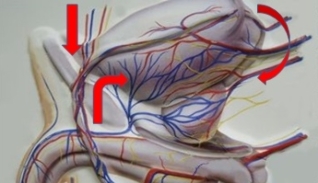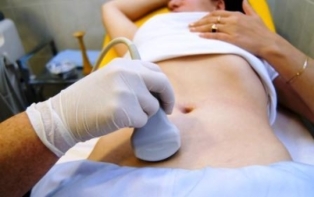The varicose vein pelvic or the syndrome of chronic pelvic pain is still exotic disease with unclear diagnostic boundaries for many doctors.
This explains the fact that some doctors in a long time "does not notice" this disease for their patients, while others place this diagnosis almost every second a person suffering from permanent unexplained pain in the lower abdomen.
Meanwhile, the timely detection of varicosity of pelvic veins depends largely on the quality of life of the patient, the patient's ability to appreciate the intimate side of the relationship with another person, and the opportunity to continue their family.
The phenomenon of chronic pelvic pain is known in medicine for a long time. But only relatively recently became known the most probable of its cause – varicose vein pelvic. This disease was described for the first time in 1975 and up to now studied it quite well.

Most likely, this pathology develops according to the following algorithm:
- Venous Plexus in the pelvis is a complex training, which includes as large trunks of vessels, and the smallest veins. By doing this, the venous system of the pelvic region in men and women is distinguished by its structure, which determines sexual specification of the disease is much more common in the fairer sex.
- Because of the compression of the vessels, partial or total clogging of venous channels, changes in the tonus of the vascular wall that disrupted the flow of blood from the pelvic veins.
- Following the vienna stop of the exercise of its functions in its entirety: progresses venous insufficiency of the valves, and disrupted blood flow normal.
- In pelvic veins beginning of the stagnation related to the inverse of the reflux of blood through the vessels – it causes a dilation of the veins and the development of varicosity.
The symptoms of varicose veins (varicosity) of the veins internal pelvic organs significantly more frequent in women of child-bearing age than in men. Often suffer ovary vienna – in 85% of cases.
The main symptom is the pain that is recorded more than 90% of patients. And here is the prevalence of this disease among the population so far, is not clear: according to studies, it is 6 to 80%. Such a difference in the "testimony" only explained the lack of qualification of doctors-диагностов at the time of diagnosis.
Causes and risk factors
The causes of varicosity are the changes in the body that can trigger the launch mechanism and pathology of this disease:
| Anatomo-physiological reason varicosity | What could cause this |
| A mechanical pressure on the pelvic veins |
|
| The modification of vascular tone |
|
| The obstruction of the pelvic veins |
|

The factors of increased risk of varicosity basin are:
- intense physical work;
- not enough regular or poor sexual life;
- abuse in intimate life, chopped the sexual act;
- a large number of pregnancies and childbirth;
- frequent gynecological diseases;
- contraception using hormonal drugs;
- hormonal disturbances in the body;
- the physical inactivity.
The classification and the phase of varicosity
In a medical environment taken from a conditional division varicosity of the basin of the nature of the course on varicosity veins of perineum and external genital organs (e.g., lips) syndrome and venous plethoras pelvic. This classification is not of great practical importance, because in most cases, the patients experiencing these two forms at the same time, causing the appearance of the other.
You can also meet with an classification of diseases at the origin of its appearance. In this regard, varicosity the pelvis is divided into:
- original – called unsatisfactory work of venous valves;
- secondary – develops as a complication available inflammatory, gynaecological or cancer of the internal organs.
There is also an attempt of classification of the disease on the basis of the degree of severity of the pathology. In this regard, secrete the step 3 of the varicosity:
| The stadium | Characteristics affected by the veins | |
| diameter (in mm) | location | |
| The first | less than 5 | any pelvic venous plexus |
| The second | 6 to 10 | the ovaries or the uterus |
| The third | more than 10 | total joint replacement of the defeat of the veins of the small pelvis |
As it is dangerous and if the consequences
This type of vascular pathology can not be called a fatal disease. The time is short, it lends itself well to the medical of the correction. But the whole problem lies in the fact that the discover is not so simple. In this their role and the lack of knowledge of the disease, and the low awareness of most doctors диагностов.

And it turns out that the patients years suffer from this disease, not even know it. And in their body during this time occurs a number of irreversible changes:
- varicosity progresses in the disease process are included the areas, it is varicose veins of the organs of reproduction (for example, varicosity of the penis), perineum and lower limbs.
- Appears resistant to the dysfunction of internal genital organs, which can lead to infertility or inability to carry out a pregnancy in women.
- On the bottom of the pain develop a variety of psychoemotional of the violation by the type of neurasthenia.
- Because of the chronic pain, growing in intimacy, the person can refuse sex.
- The most rare and at the same time the most serious complications, pelvic varicosity are considered as venous thrombosis and pulmonary thromboembolism. They occur in approximately 5% of cases, but always fatal.
The symptoms
The characteristic symptoms of varicose veins and vessels of the pelvis, requiring the use of a doctor for the treatment, including:
- The chronic pain. The pain is most often localized in the lower abdomen, sometimes, "give", in the groin and lower back. Are strengthened in the second half of the menstrual cycle in women, after intercourse or standing for prolonged on the feet.
- Of the genital tract. This is typically "feminine" is a symptom. In this selection the standard view and have no foreign smell. The patient is alarming that, exceptionally, a large number.
- The external signs of the disease – spider veins or strengthening venous of the image on the hips and the crotch – occurs in about half of the patients. Men may notice a slight dilation of the veins on the penis.
- Disorders of the menstrual cycle in women, and micturition disorders in patients of both sexes is rare and a testament to its advanced form of the disease.
When to see a doctor and to what?
Reason for the treatment to your doctor may be one of the symptoms described above. Not delay, because to determine the real causes of the discomfort and the appointment of an effective treatment will take a lot of time.
An expert of this disease is a doctor phlebology, but for women may be an initial visit to a gynecologist, who will absence of the comorbidity of gynecological diseases.

The diagnosis
According to american researchers, in the early 2000s, only 2% of patients with varicosity basin initially placed at the correct diagnosis. Sometimes, the result of the error diagnostic is now to remove the genital organs in women, although this could be avoided, if used the specific methods of diagnosis of the basin of varicosity:
- ULTRASOUND and Doppler study of the veins – gives the possibility to suspect varicosity;
- Phlebography – invasive study which allows to determine with accuracy the presence and extent of the disease;
- Laparoscopy – essential in the differential diagnosis of varicosity of the pelvic region of similar on the symptoms of gynecological diseases (endometriosis, fibroids, кольпит).
- Selective variography – the study of the state of the veins with the help of the introduction of a contrast medium, is considered as the most objective diagnostic method.
- Computer or magnetic resonance imaging can clarify the details of the progress of the disease and differentiate it from other pathologies with similar symptoms (joint pain of the disease, Crohn's disease, and others).
The methods of treatment
In the treatment of varicosity of the basin are the following:
- normalize the tone of the vessels;
- improve the nutrition of the tissue;
- avoid stagnation and possible complications.
The treatment of varicosity of the vessels of the pelvis can move in several directions, a surgical intervention is required for the 3 stages of the disease.
| Therapeutic management | Specific activities |
| The therapy without medication |
|
| Drug therapy |
|
| Surgery |
|
| Treatment ways | the use of herbal remedia on the basis of dandelion, chagas and horse-chestnut |

The forecasts and measures of prevention
Completely heal the varicose vein pelvic without surgery is almost impossible. With the help of the curator of the medicine can greatly ease and even eliminate most of the unpleasant symptoms and to dramatically reduce the risk of complications of the disease. The operation is not an absolute guarantee that the disease will not return.
In order to avoid a relapse of the disease , you must always follow the right lifestyle:
- do not smoke;
- do not use hormonal drugs uncontrollable;
- more moving and less standing still;
- respect antisclerotic a diet with lots of plant foods fresh;
- every day to perform the healing services of gymnastics and breathing exercises for maintaining the health of the vessels;
- after having performed a surgical operation on the subject of varicosity, you need to wear compression and to take prevention of the dose prescribed by your doctor of the medicines venotonics.
Pelvic varicosity – this hidden beach of the health of women, a kind of disease of a ghost, to discover that it is difficult, but to suffer for him is true.
The main symptom of the disease are chronic pelvic pain, which may disturb the patient in time and become a source of refusal of the pleasures of life. Tolerate such a malaise and not talk to a doctor.
During the onset of specific symptoms it is important to understand that it is abnormal and immediately seek the help of a specialist.




































